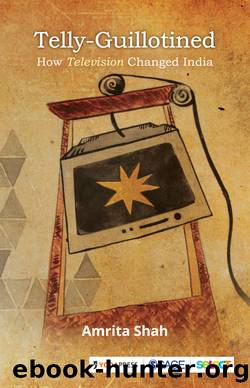Telly-Guillotined by Shah Amrita;

Author:Shah, Amrita; [Shah, Amrita]
Language: eng
Format: epub
Publisher: SAGE Publications
Published: 2019-05-03T00:00:00+00:00
LOVE FOR SALE
14 FEBRUARY 1995. SHOPS AND fast food joints in Mumbai city were festooned with banners wishing patrons a Happy Valentineâs Day. Entire pages of dailies were filled with soppy prepaid messages from people with names like Nasir, Aswini, Raj, Auntie Chips, Stranger, jaan, Charlie and Bond. Radio FM played sentimental songs through the day. Confectioners churned out heart-shaped pastries. Restaurants hosted special candlelight dinners. Love, or some version of it, was most certainly in the air.
A traveller arriving in Mumbai on that particular day could have been forgiven for wondering, at least momentarily, if he had landed up in some western capital rather than a place with professedly ancient local traditions and deeply conservative norms regarding relations between the sexes.
The phenomenon was startlingly sudden even for us native Mumbai-dwellers. A friend whose mother had her birthday on the same day looked at the wilting flowers and soggy cake, the best that she had managed to procure amid the bedlam, and shook her head in bewilderment: âI donât know whatâs come over everyone.â
The answer was really quite simple: India or at least its metropolitan cities had been initiated into the global brotherhood of Romance Inc., the most basic principle of which was that the demonstration of ardour was an expensive thing. Consider for instance some of the options that were dangled before Mumbaiâs amorous couples on V Day 1995. Endless love at Sheetal Again, a six-course Valentine dinner at Cafe Royal; Hugs n Misses at Leoâs Pub, cost: 400â2000 for two. Feeling âthe experienceâ at Shopperâs Stop, cost: no limit. Archieâs card, the absolutely minimum requirement on the teenage circuit, cost: 10â35.
More money was spent on saying âI love youâ on that one day than had probably been spent over the previous 10 years. And the single factor responsible for turning an obscure foreign ritual into a momentous event at least as far the young, westernised Indian elite was concerned, was the media.
Weeks before the event, Star TVâs various channels had been choc-a-bloc with ads, fillers and programmes on the theme, including random interviews with people on the streets of Hong Kong (âWhat do you expect to receive on Valentineâs Day?: Flowers/candlelight dinner/diamond Ringâ). Shops selling gift items announced competitions and prizes. Spurred by the apparent flurry, newspapers and magazines got into the act, carrying articles on the âcard crazeâ and the origins of St. Valentineâs Day.
By the time the day rolled up the hype had snowballed enough to enter the consciousness of a vast number of Indians and sent a considerable number scurrying to the nearest card/flower/ cake/jewellery/soft toy/assorted gift shop, a simple case of love meeting commerce in perfect harmony.
Then again what was new? After all what was the Indian convention of âarranged marriageâ (where caste, religion, social status and money were the prime criteria) but a semi-business proposition; a trade-off between families where, in many cases, the prospective couple did not even set eyes on each other till the day of the wedding? True, some movement had occurred in the romance department over the last couple of decades or so.
Download
This site does not store any files on its server. We only index and link to content provided by other sites. Please contact the content providers to delete copyright contents if any and email us, we'll remove relevant links or contents immediately.
| Africa | Americas |
| Arctic & Antarctica | Asia |
| Australia & Oceania | Europe |
| Middle East | Russia |
| United States | World |
| Ancient Civilizations | Military |
| Historical Study & Educational Resources |
The Battle of Mogadishu by Matt Eversmann & Dan Schilling(723)
The Confidence Men by Margalit Fox(674)
The Spymaster of Baghdad by Margaret Coker(643)
A History of the Muslim World since 1260: The Making of a Global Community by Vernon O. Egger(642)
Jack the Ripper and the East End by Peter Ackroyd(611)
Empire of Fear: Inside the Islamic State by Andrew Hosken(589)
The Afghanistan File by Prince Turki AlFaisal Al Saud(586)
The Crimean War by Winfried Baumgart(579)
Islam At The Gates: How Christendom Defeated the Ottoman Turks by Diane Moczar(574)
The Jerusalem Diamond by Noah Gordon(568)
Akhenaten by Dominic Montserrat(566)
A Concise History of Greece (Cambridge Concise Histories) by Richard Clogg(556)
Beirut 2020 by Charif Majdalani(555)
The History of Jihad by Robert Spencer(550)
Enemy in the East by Rolf-Dieter Müller(536)
Israel: Ancient Kingdom or Late Invention? by Daniel I. Block(532)
The Privatization of Israeli Security by Shir Hever(527)
The Nine Lives of Pakistan by Declan WALSH(522)
Destroying a Nation: The Civil War in Syria by Nikolaos van Dam(516)
